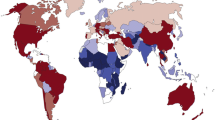Abstract
Objective
Globally, cesarean section (CS) rate is close to 26 %. Nepal has a reported CS rate of 5 %, with huge differences in rural (3.5 %) and urban (15 %) areas. The aim of the study was to determine the rate and indications for CS in a remote hospital in a rural area of Nepal.
Methods
A one-year cross-sectional prospective study from August 2014 to August 2015 was performed at Okhaldhunga Community Hospital (OCH). Semi-structured interviews of all women undergoing CS (91) were done, partly with the assistance of a local translator. A maternal waiting home is connected to the hospital.
Results
Out of the 864 births in the hospital, 91 CS were performed giving a CS rate of 9.5 %. The most frequent indications were: prolonged labor in 24 CS (26.4 %), abnormal fetal lie in 23 CS (25.3 %) and fetal distress in 18 CS (19.8 %). Three-quarters of CS were performed as an emergency. Almost half of the women stayed in the maternal waiting home prior to birth.
Conclusion
The CS rate at OCH was relatively low, within WHO’s recommendation, with types of indication similar to other countries. There were no signs of CS overuse. Maternal request was not the sole indication in any CS.

Similar content being viewed by others
References
Kupari M, Talola N, Luukkaala T, et al. Does an increased cesarean section rate improve neonatal outcome in term pregnancies? Arch Gynecol Obstet. 2015. doi:10.1007/s00404-015-3942-4.
Prakash KC, Neupane S. Cesarean deliveries among Nepalese mothers: changes over time 2001–2011 and determinants. Arch Gynecol Obstet. 2014;289(2):421–7.
World Health Organization. World health statistics 2015. http://apps.who.int/iris/bitstream/10665/170250/1/9789240694439_eng.pdf?ua=1&ua=1. Published 2015. Accessed 24 Sept 2015.
Karkee R, Lee AH, Khanal V, et al. Obstetric complications and cesarean delivery in Nepal. Int J Gynaecol Obstet. 2014;125(1):33–6.
Irani M, Deering S. Challenges affecting access to cesarean delivery and strategies to overcome them in low-income countries. Int J Gynaecol Obstet. 2015;131(1):30–4.
World Health Organization. Monitoring emergency obstetric care. http://whqlibdoc.who.int/publications/2009/9789241547734_eng.pdf?ua=1. Published 2009. Accessed 18 Mar 2015.
United Nations. UN millenium goal 5. http://www.un.org/millenniumgoals/pdf/Goal_5_fs.pdf. Published 2013. Accessed December 4, 2015.
Amoako Johnson F, Padmadas SS, Matthews Z. Are women deciding against home births in low and middle income countries? PLoS One. 2013;8(6):e65527.
United Nations. UN millenium goals. http://www.un.org/millenniumgoals/. Published 2015. Accessed 24 Sept 2015.
UN. UN millenniumgoal 5. http://www.un.org/millenniumgoals/pdf/Goal_5_fs.pdf. Published 2013. Accessed 04 Dec 15.
Rijken MJ, Meguid T, van den Akker T, et al. Global surgery and the dilemma for obstetricians [letter to the editors]. Lancet. 2015;386:1941–2.
Karlstrom A, Lindgren H, Hildingsson I. Maternal and infant outcome after caesarean section without recorded medical indication: findings from a Swedish case-control study. BJOG. 2013;120(4):479–86 (discussion 486).
Øian P. Veileder i fødselshjelp (obstetric guidelines). http://legeforeningen.no/Fagmed/Norsk-gynekologisk-forening/Veiledere/Veileder-i-fodselshjelp-2014/. Published 2014. Accessed 25 Feb 2015.
The American College of Obstetricians and Gynecologists (ACOG). ACOG committee opinion no. 559: cesarean delivery on maternal request. Obstet Gynecol 2013;121(4):904–07.
Abalos E, Oyarzun E, Addo V, et al. CORONIS—international study of caesarean section surgical techniques: the follow-up study. BMC Pregnancy Childbirth. 2013;13:215.
Mi J, Liu F. Rate of caesarean section is alarming in China. Lancet. 2014;383(9927):1463–4.
Ministry of Health and Population; New Era; ICF International. Nepal Demographic and Health Survey 2011. http://dhsprogram.com/pubs/pdf/FR257/FR257%5B13April2012%5D.pdf. Published 2012. Accessed 5 Feb 2015.
World Health Organization. World health statistics 2014. http://apps.who.int/iris/bitstream/10665/112738/1/9789240692671_eng.pdf?ua=1. Published 2014. Accessed 14 Mar 2015.
Robson MS. Can we reduce the caesarean section rate? Best Pract Res Clin Obstet Gynaecol. 2001;15(1):179–94.
Bohler E. It is dangerous to become a mother. Tidsskr Nor Laegeforen. 2011;131(19):1913–4.
Ehtisham S, Akhtar Hashmi H. Determinants of caesarean section in a tertiary hospital. J Pak Med Assoc. 2014;64(10):1175–8.
Viphou N, Brook AJ, Liljestrand J. Clinical indications for cesarean delivery in a Cambodian referral hospital. Int J Gynaecol Obstet. 2014;124(1):83–4.
Organisation for Economic Co-operation and Development. Health at a glance 2013: OECD indicators. http://www.oecd.org/els/health-systems/Health-at-a-Glance-2013.pdf. Published 2013. Accessed 5 Feb 2015.
Acknowledgments
The authors L.J. Samdal and K. R. Steinsvik were supported economically by a Norwegian scholarship named Generalkonsul Tønder Bull og hustru Valborg Bulls legat til medisinsk forskning. The funding sources had no involvement in the study design; collection, analysis, or interpretation of data; in the writing of the article; or in the decision to submit it for publication.
Author information
Authors and Affiliations
Corresponding author
Ethics declarations
Conflict of interest
The authors declare that there are no conflicts of interest.
Ethical Approval
All procedures performed in studies involving human participants were in accordance with the ethical standards of the institutional and/or national research committee and with the 1964 Helsinki Declaration and its later amendments or comparable ethical standards.
Animal and Human Rights
This article does not contain any studies with animal subjects.
Additional information
Live Johanne Samdal is a medical student in Faculty of Medicine at University of Oslo, Oslo, Norway; Kristina Reberg Steinsvik is a medical student in Faculty of Medicine at University of Oslo, Oslo, Norway; Prakash Pun, M.D., at Okhaldhunga Community Hospital in Okhaldhunga, Nepal; Phanindra Dani, Hospital Pharmacist, at Okhaldhunga Community Hospital in Okhaldhunga, Nepal; Borghild Roald, prof. dr. med, in Faculty of Medicine at University of Oslo, Oslo, Norway; Babill Stray-Pedersen, prof. dr. med., in Faculty of Medicine at University of Oslo, Oslo, Norway; Erik Bøhler, M.D., at Okhaldhunga Community Hospital in Okhaldhunga, Nepal.
Rights and permissions
About this article
Cite this article
Samdal, L.J., Steinsvik, K.R., Pun, P. et al. Indications for Cesarean Sections in Rural Nepal. J Obstet Gynecol India 66 (Suppl 1), 284–288 (2016). https://doi.org/10.1007/s13224-016-0890-2
Received:
Accepted:
Published:
Issue Date:
DOI: https://doi.org/10.1007/s13224-016-0890-2




